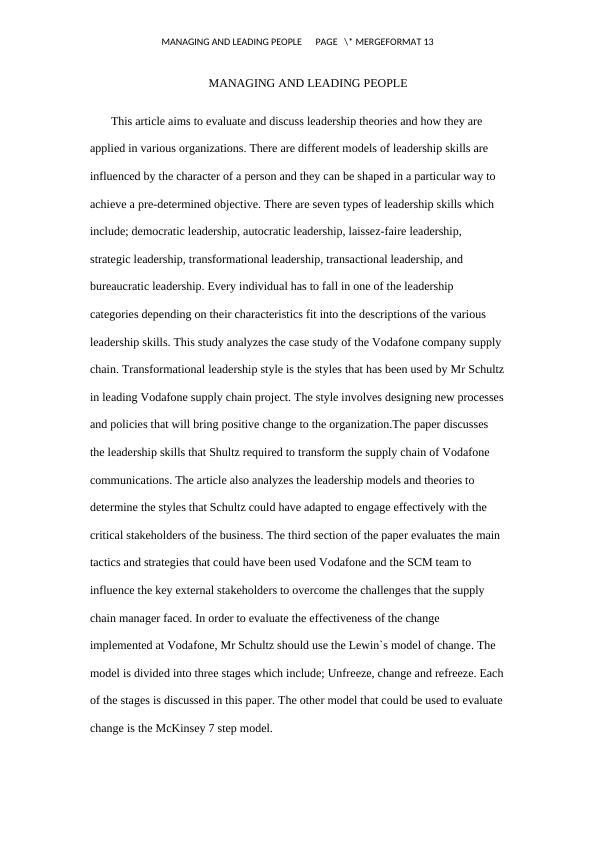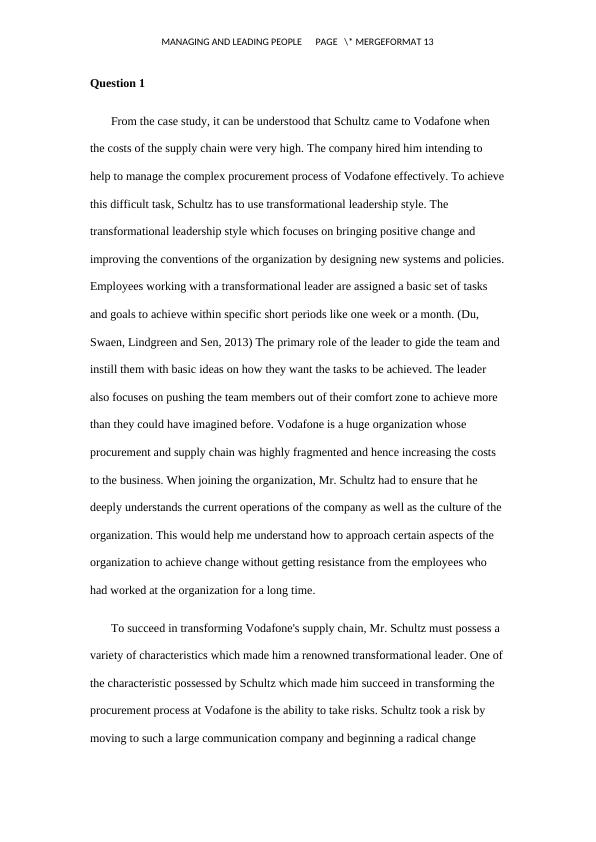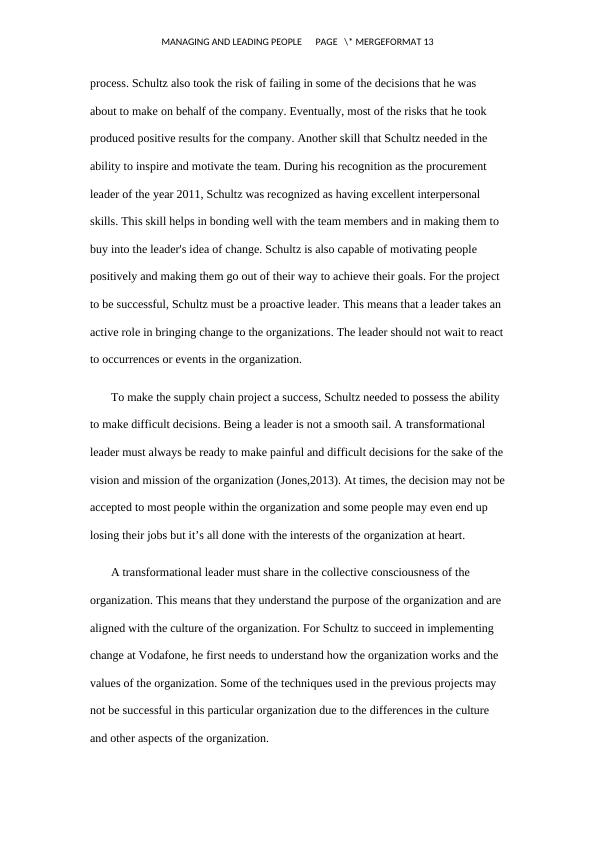Leadership Theories in Organizations
Added on 2023-04-26
13 Pages3404 Words262 Views
MANAGING AND LEADING PEOPLE PAGE \* MERGEFORMAT 13
MANAGING AND LEADING PEOPLE
Name of student:
Registration number:
Unit Title:
Unit Code:
Name of supervisor:
Date due:
MANAGING AND LEADING PEOPLE
Name of student:
Registration number:
Unit Title:
Unit Code:
Name of supervisor:
Date due:

MANAGING AND LEADING PEOPLE PAGE \* MERGEFORMAT 13
MANAGING AND LEADING PEOPLE
This article aims to evaluate and discuss leadership theories and how they are
applied in various organizations. There are different models of leadership skills are
influenced by the character of a person and they can be shaped in a particular way to
achieve a pre-determined objective. There are seven types of leadership skills which
include; democratic leadership, autocratic leadership, laissez-faire leadership,
strategic leadership, transformational leadership, transactional leadership, and
bureaucratic leadership. Every individual has to fall in one of the leadership
categories depending on their characteristics fit into the descriptions of the various
leadership skills. This study analyzes the case study of the Vodafone company supply
chain. Transformational leadership style is the styles that has been used by Mr Schultz
in leading Vodafone supply chain project. The style involves designing new processes
and policies that will bring positive change to the organization.The paper discusses
the leadership skills that Shultz required to transform the supply chain of Vodafone
communications. The article also analyzes the leadership models and theories to
determine the styles that Schultz could have adapted to engage effectively with the
critical stakeholders of the business. The third section of the paper evaluates the main
tactics and strategies that could have been used Vodafone and the SCM team to
influence the key external stakeholders to overcome the challenges that the supply
chain manager faced. In order to evaluate the effectiveness of the change
implemented at Vodafone, Mr Schultz should use the Lewin`s model of change. The
model is divided into three stages which include; Unfreeze, change and refreeze. Each
of the stages is discussed in this paper. The other model that could be used to evaluate
change is the McKinsey 7 step model.
MANAGING AND LEADING PEOPLE
This article aims to evaluate and discuss leadership theories and how they are
applied in various organizations. There are different models of leadership skills are
influenced by the character of a person and they can be shaped in a particular way to
achieve a pre-determined objective. There are seven types of leadership skills which
include; democratic leadership, autocratic leadership, laissez-faire leadership,
strategic leadership, transformational leadership, transactional leadership, and
bureaucratic leadership. Every individual has to fall in one of the leadership
categories depending on their characteristics fit into the descriptions of the various
leadership skills. This study analyzes the case study of the Vodafone company supply
chain. Transformational leadership style is the styles that has been used by Mr Schultz
in leading Vodafone supply chain project. The style involves designing new processes
and policies that will bring positive change to the organization.The paper discusses
the leadership skills that Shultz required to transform the supply chain of Vodafone
communications. The article also analyzes the leadership models and theories to
determine the styles that Schultz could have adapted to engage effectively with the
critical stakeholders of the business. The third section of the paper evaluates the main
tactics and strategies that could have been used Vodafone and the SCM team to
influence the key external stakeholders to overcome the challenges that the supply
chain manager faced. In order to evaluate the effectiveness of the change
implemented at Vodafone, Mr Schultz should use the Lewin`s model of change. The
model is divided into three stages which include; Unfreeze, change and refreeze. Each
of the stages is discussed in this paper. The other model that could be used to evaluate
change is the McKinsey 7 step model.

MANAGING AND LEADING PEOPLE PAGE \* MERGEFORMAT 13
Question 1
From the case study, it can be understood that Schultz came to Vodafone when
the costs of the supply chain were very high. The company hired him intending to
help to manage the complex procurement process of Vodafone effectively. To achieve
this difficult task, Schultz has to use transformational leadership style. The
transformational leadership style which focuses on bringing positive change and
improving the conventions of the organization by designing new systems and policies.
Employees working with a transformational leader are assigned a basic set of tasks
and goals to achieve within specific short periods like one week or a month. (Du,
Swaen, Lindgreen and Sen, 2013) The primary role of the leader to gide the team and
instill them with basic ideas on how they want the tasks to be achieved. The leader
also focuses on pushing the team members out of their comfort zone to achieve more
than they could have imagined before. Vodafone is a huge organization whose
procurement and supply chain was highly fragmented and hence increasing the costs
to the business. When joining the organization, Mr. Schultz had to ensure that he
deeply understands the current operations of the company as well as the culture of the
organization. This would help me understand how to approach certain aspects of the
organization to achieve change without getting resistance from the employees who
had worked at the organization for a long time.
To succeed in transforming Vodafone's supply chain, Mr. Schultz must possess a
variety of characteristics which made him a renowned transformational leader. One of
the characteristic possessed by Schultz which made him succeed in transforming the
procurement process at Vodafone is the ability to take risks. Schultz took a risk by
moving to such a large communication company and beginning a radical change
Question 1
From the case study, it can be understood that Schultz came to Vodafone when
the costs of the supply chain were very high. The company hired him intending to
help to manage the complex procurement process of Vodafone effectively. To achieve
this difficult task, Schultz has to use transformational leadership style. The
transformational leadership style which focuses on bringing positive change and
improving the conventions of the organization by designing new systems and policies.
Employees working with a transformational leader are assigned a basic set of tasks
and goals to achieve within specific short periods like one week or a month. (Du,
Swaen, Lindgreen and Sen, 2013) The primary role of the leader to gide the team and
instill them with basic ideas on how they want the tasks to be achieved. The leader
also focuses on pushing the team members out of their comfort zone to achieve more
than they could have imagined before. Vodafone is a huge organization whose
procurement and supply chain was highly fragmented and hence increasing the costs
to the business. When joining the organization, Mr. Schultz had to ensure that he
deeply understands the current operations of the company as well as the culture of the
organization. This would help me understand how to approach certain aspects of the
organization to achieve change without getting resistance from the employees who
had worked at the organization for a long time.
To succeed in transforming Vodafone's supply chain, Mr. Schultz must possess a
variety of characteristics which made him a renowned transformational leader. One of
the characteristic possessed by Schultz which made him succeed in transforming the
procurement process at Vodafone is the ability to take risks. Schultz took a risk by
moving to such a large communication company and beginning a radical change

MANAGING AND LEADING PEOPLE PAGE \* MERGEFORMAT 13
process. Schultz also took the risk of failing in some of the decisions that he was
about to make on behalf of the company. Eventually, most of the risks that he took
produced positive results for the company. Another skill that Schultz needed in the
ability to inspire and motivate the team. During his recognition as the procurement
leader of the year 2011, Schultz was recognized as having excellent interpersonal
skills. This skill helps in bonding well with the team members and in making them to
buy into the leader's idea of change. Schultz is also capable of motivating people
positively and making them go out of their way to achieve their goals. For the project
to be successful, Schultz must be a proactive leader. This means that a leader takes an
active role in bringing change to the organizations. The leader should not wait to react
to occurrences or events in the organization.
To make the supply chain project a success, Schultz needed to possess the ability
to make difficult decisions. Being a leader is not a smooth sail. A transformational
leader must always be ready to make painful and difficult decisions for the sake of the
vision and mission of the organization (Jones,2013). At times, the decision may not be
accepted to most people within the organization and some people may even end up
losing their jobs but it’s all done with the interests of the organization at heart.
A transformational leader must share in the collective consciousness of the
organization. This means that they understand the purpose of the organization and are
aligned with the culture of the organization. For Schultz to succeed in implementing
change at Vodafone, he first needs to understand how the organization works and the
values of the organization. Some of the techniques used in the previous projects may
not be successful in this particular organization due to the differences in the culture
and other aspects of the organization.
process. Schultz also took the risk of failing in some of the decisions that he was
about to make on behalf of the company. Eventually, most of the risks that he took
produced positive results for the company. Another skill that Schultz needed in the
ability to inspire and motivate the team. During his recognition as the procurement
leader of the year 2011, Schultz was recognized as having excellent interpersonal
skills. This skill helps in bonding well with the team members and in making them to
buy into the leader's idea of change. Schultz is also capable of motivating people
positively and making them go out of their way to achieve their goals. For the project
to be successful, Schultz must be a proactive leader. This means that a leader takes an
active role in bringing change to the organizations. The leader should not wait to react
to occurrences or events in the organization.
To make the supply chain project a success, Schultz needed to possess the ability
to make difficult decisions. Being a leader is not a smooth sail. A transformational
leader must always be ready to make painful and difficult decisions for the sake of the
vision and mission of the organization (Jones,2013). At times, the decision may not be
accepted to most people within the organization and some people may even end up
losing their jobs but it’s all done with the interests of the organization at heart.
A transformational leader must share in the collective consciousness of the
organization. This means that they understand the purpose of the organization and are
aligned with the culture of the organization. For Schultz to succeed in implementing
change at Vodafone, he first needs to understand how the organization works and the
values of the organization. Some of the techniques used in the previous projects may
not be successful in this particular organization due to the differences in the culture
and other aspects of the organization.

End of preview
Want to access all the pages? Upload your documents or become a member.
Related Documents
Leadership Styles and Tactics for Supply Chain Transformation at Vodafonelg...
|11
|2991
|56
Leadership Types and Skills in Vodafone's Case Studylg...
|7
|1609
|146
Leadership: Styles, Skills and Organizational Measureslg...
|12
|2870
|59
Managing and Leading Peoplelg...
|13
|3985
|42
Leadership in Businesslg...
|16
|3645
|352
Leadership in Education Paper 2022lg...
|13
|3666
|7
